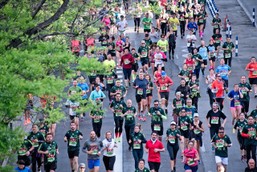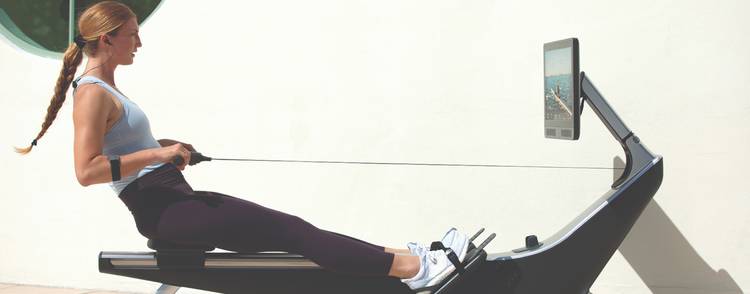
How to Successfully Run Your First Marathon: Tips for Success Rain or Shine
Running your first marathon is no small feat. It’s a monumental achievement that requires physical and mental preparation, dedication, and perseverance. But the road to 42 km also comes with tons of health benefits, like improving your cardiovascular endurance, building strength, and an overwhelming sense of accomplishment.
Like any big goal, having the proper plan in place is important for success. In this article, we’ll cover:
- Building and increasing your marathon mileage
- Proper nutrition during marathon prep
- How to train for a marathon in Vancouver, Canada’s unpredictable weather
- How to incorporate treadmill into your marathon training
- A schedule of Vancouver’s popular marathon races
Essential Elements of a Successful Marathon Training Plan
You have to learn to walk before you can run, right? Especially if that run is a marathon.
Before you start your marathon training, it’s important to build a base. A well-planned, structured approach will not only prepare your body for the demands of running 42 km but is also essential for preventing injury.
Here are the key elements to include in your marathon training plan.
Building a Strong Foundation
Running a marathon presents more challenges than your nightly neighborhood runs. And whether you’re just starting out or you’re a seasoned runner, having a strong fitness foundation is step number one to conquering your goal. Here are some tips to build your base:
Base Mileage
Slow and steady wins this race. Building up your base mileage is a gradual process. And before you can run 26.2 miles at once, you need to start with around 20 a week.
Over the course of a 12-20 week training plan, beginner runners should start with 20 miles a week and work their way up to 50+. This schedule will include 2-3 short runs, 2 mid-length, and one long run per week.
A sample base mileage training plan for a beginner could look something like this:
| Monday | 2 Km |
| Tuesday | 5 Km |
| Wednesday | Rest |
| Thursday | 4 Km |
| Friday | 3 Km |
| Saturday | 8 Km |
| Sunday | 1 Km (Recovery Run) |
Cross-Training for Strength
Muscular endurance is equally important as cardiovascular endurance when it comes to marathon training. During prep, your sole focus is on your legs and how far they can take you. Cross-training and weightlifting for strength allow you to build key muscles in your upper and lower body that will prevent imbalances and make you a more efficient runner.
Injury Prevention
An injury is the fastest way to derail your marathon training progress. Combining excessive training with a lack of recovery sessions can lead to something known as “overtraining syndrome”. Incorporating low-impact exercise (cross-training), stretching, wearing the right running shoes, and having the correct running form all help you stay injury-free.
Increasing Mileage and Intensity
After the first few weeks of marathon prep, you’ll want to start diversifying your training plan. A few ways to do this are through gradual progressive overload (slowly adding more miles), interval training, and hill workouts.
Gradual Progression
This technique is also known as progressive overload. When training for a marathon you want to slowly increase your weekly running mileage by about 10% – 15% per week until you hit around 50 weekly kilometers. A slow progression helps you avoid overtraining syndrome while building the cardiovascular endurance needed to complete the race.
Interval Training
Interval training is an effective form of speedwork that can help make you a more efficient marathon runner. It challenges the amount of time you can sustain a certain pace and speed, which ultimately helps you push the pace on your steady-state runs.
5 types of interval training you can use to prep for a marathon are
Fueling Your Body for Marathon Running
When training for a marathon, keep in mind that your calorie expenditure will be higher than normal. This means it’s crucial to consume enough calories to sustain your rigorous running schedule.
You wouldn’t put diesel in a gas-powered car. So when training, make sure you fuel your body with the nutrients it needs to perform as a high-powered machine. Be sure to incorporate an appropriate amount of carbohydrates, fats, and proteins into your diet.
Pay close attention to your carb intake. Your body turns carbs into glycogen and stores it in your muscles for energy during exercise. A tip to maintain your glycogen stores on long runs is to keep energy gels and chews on hand. They contain quick-acting carbs that will replenish your glycogen when you’re running on E.
And don’t forget, drink plenty of water during training. High-intensity runs and warm weather can lead to dehydration, cramping, and electrolyte loss. So be sure to keep plenty of H2O and sports electrolyte drinks on hand!
How to Train for a Marathon in Vancouver, Canada
Consistency is key when it comes to successful marathon training. But maintaining an outdoor training routine can be tough when living in Vancouver, Canada.
While Vancouver offers several scenic routes, including the iconic seawall, it’s also known for its unpredictable (and wet) weather. With an average of 166 rainy days per year, it’s important to have the right equipment on hand so you can train rain or shine.
Tips for Treadmill Training
Not only does treadmill training offer you the luxury of running at a time that works for you (does anyone actually like running when it’s pitch black outside?), but it also helps alleviate some discomforts that come with road running.
Treadmills like the LifeSpan TR5500iM feature treadmill belts with built-in shock absorbers. Alternating running on the pavement with a cushioned treadmill belt helps reduce stress and pressure from your shins, knees, and ankles. Ultimately, treadmill training sessions can help prevent injury and decrease the recovery time needed between runs.
But to truly mimic outdoor running, non-motorized treadmills are a great option. These treadmills, like the AssaultRunner Pro, feature a curved, manually powered belt that is self-paced and simulates open-road running. Since there is no motor, all the power comes from your stride which gives you the chance to really focus on your running form, without any potholes to maneuver.
Top 5 Treadmill Training Tips for Marathon Runners:
1. Set the Incline: When running on a treadmill, it’s important to set the incline to at least 1% since the 0% grade is unrealistically flat. This will help to simulate outdoor running conditions and engage more muscles, maximizing your training.
2. Programmed Workouts: Some treadmills come standard with pre-programmed workouts. Using these settings is a great way to mix up your workouts and incorporate different types of runs; like speed intervals, hill workouts, and long runs.
3. Use a Pace Guide: One of the benefits of treadmill training is that you can easily control your pace. Picking a pace can be tricky when running outdoors, especially for beginners. Using a pacing guide on a treadmill helps you maintain a consistent speed throughout your workout.
4. Use a Heart Rate Monitor: A heart rate monitor can help you track the intensity of your run and ensure that you stay within your target heart rate zone to maximize training benefits. When you notice your heart rate spiking too high, you can adjust your pace to bring it back in line.
5. Incorporate Entertainment: For most, long-distance running can be monotonous. One of the biggest advantages of running on a treadmill with a monitor is staying entertained. Watch your favorite shows or turn on a virtual running video if you want to feel like you’re in the great outdoors.
Planning your Marathon Race
Picking your marathon helps you set realistic training goals. When choosing a race, consider things like your current fitness level, time constraints, and other commitments like work and kids. Remember that the average marathon training plan should be between 12-20 weeks to have ample time to prepare.
With that in mind, let’s look at some upcoming marathons in Vancouver, BC, Canada:
1. The Vancouver Sun Run: An annual 10 km road race that takes place in Vancouver, BC, Canada. It is one of the largest 10K races in the world, typically attracting over 40,000 participants each year. The event usually takes place in April, and the course runs through downtown Vancouver, starting and finishing at BC Place Stadium.
2. BMO Vancouver Marathon: This is the largest marathon event in Vancouver that usually takes place in May. It offers a full marathon, half marathon, 8K run, and kids run.
3. Scotiabank Vancouver Half Marathon: This event typically takes place in June and offers a half marathon and 5K run.
4. Vancouver Eastside 10K: This is a 10K race that typically takes place in September and runs through the historic neighbourhoods of East Vancouver.
5. Granville Island Turkey Trot: This is a Thanksgiving Day event that usually takes place in October and offers a 10K run, 5K run, and a kids run.
6. Fall Classic Run at UBC: This is a November event that offers a half marathon, 10K run, and 5K run.
A final note, be aware that some factors, like the weather, will be completely out of your control. Just in case, come prepared for rain on your big day

Final Thoughts on Marathon Training
Proper preparation is the key to success when it comes to marathon training. Taking the time to build your base, gradually increase your mileage, and commit to proper nutrition requires immense dedication. But with the right preparation, equipment, and consistency, you’ll take big strides toward your goal of crossing the finish line.
Don’t forget, there’s strength in numbers! We recommend finding a supportive community of runners who can help keep you accountable and motivated. And here at Fitness Town, we’re always here to support you on your journey to 42 km.
If you’re tired of the rain stalling your progress, stop by one of our stores and come chat treads. Our equipment experts will help you find the treadmill that’s right for you and your running style.


